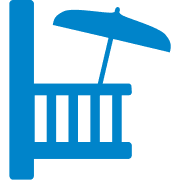Roofs, roof details, roof repairs
Triflex roofing systems are designed to avoid the requirement for regular maintenance as far as possible. As a matter of good housekeeping, it is recommended that the Triflex system(s) and the roof generally are subject to general maintenance and inspection at least twice annually, ideally in the Spring and Autumn.
Maintenance
- Ensure the roof can be accessed safely following the relevant Health and Safety procedures
- Remove any debris from the roof area, and all items which could potentially cause damage to the Triflex system(s) - do not flush down outlets
- Carefully remove any plant growth ensuring the waterproofing is not damaged
- Check and clean outlets, drainage points, gutters, downspouts etc.
- Ensure that all rainwater goods are working effectively and there are no blockages, removing lids of inspection chambers and access grilles where necessary
- If possible cut back overhanging tree limbs so there is a minimum 1 metre clearance around the roof edge to minimise the risk of blocked drainage through leaves
Inspection
- Check all details visually to ensure a sound bond to the substrate
- Check the installed Triflex system(s) for any signs of mechanical or chemical damage
- Check for signs of oil, lubricant or coolant leaks from plant / equipment
- Check the soffit (where visible) for evidence of water ingress, wet patches, water staining etc.
- Check that all protective metal flashings and termination bars to abutment upstands are firmly in place
- Check all mastic sealant and mortar pointing for signs of failure
- Check that hard landscaping and proprietary surface finishes e.g. paving slabs, are in good condition and secure
- Check that any items of plant / equipment that have been introduced to the roof are sited on suitable isolation, and that any fixings do not penetrate the waterproofing
- Check other building components e.g. glazing, parapet walls, rooflights etc. for soundness
The building owner should keep a record of all inspections and maintenance. Any observations that require attention to the installed Triflex system(s) should be reported as soon as possible to the original installer.
Repair
Areas of mechanical and other damage should be repaired by the original installer as soon as possible after they become evident. Contact Triflex Technical Services for specific recommendations.
Additions and removals
Prior to additions and removals taking place which may affect the integrity of the installed Triflex system(s), contact Triflex Technical Services for approved methods.
General protection
Where Triflex treated areas are likely to suffer damage or contamination from other trades during subsequent or other works, suitable precautions should be taken to protect the installed system(s).
Cleaning
Should the roof require regular cleaning, we recommend the application of an optional smooth finish, anti-skid finish or heavy duty wearing course with finish.
The roof can be cleaned using the following method:
- Manually brush away any loose particles, general dust, dirt, etc.
- Ensure all outlets, drainage points, gutters, downspouts etc. are clear and free from any blockage
- Apply a cold or warm (< 50°C) water pressure wash with Triflex approved detergent or degreasant in solution. The head of the water lance should be kept at least 500mm away from the Triflex surface at all times and the pressure should be restricted to less than 1,500psi
- Preferably leave the detergent solution on the surface for approximately 15 minutes
- For stubborn areas of dirt, gently brush or mop the surface after the detergent has been applied
- Rinse the surface with clean, cold water. The head of the water lance should be kept at least 500mm away from the Triflex surface at all times and the pressure should be restricted to less than 1500psi
- Squeegee excess water from the surface to outlets
Important note
The advice we provide on the maintenance, care and cleaning of our products is based on many years of experience and is given to the best of our knowledge, however, the wide variety of requirements for a building under the most diverse conditions mean that it is necessary to test the method or product for suitability in any given case. We reserve the right to make alterations in keeping with our technical development or improvements.
Maintenance, care and cleaning methods outside of this guidance may invalidate any warranty.
Walkways, balconies and terraces
Triflex walkway, balcony and terrace waterproofing, surfacing and protection systems are designed to avoid the requirement for regular maintenance as far as possible. As a matter of good housekeeping, it is recommended that the Triflex system(s) and the walkway, balcony or terrace generally are inspected at least twice annually, ideally in the spring and autumn.
Maintenance
- Ensure the walkway, balcony or terrace can be accessed safely following the relevant Health and Safety procedures
- Remove any debris from the walkway, balcony or terrace area and all items which could potentially cause damage to the system(s) - do not flush down outlets
- Carefully remove any plant growth
- Check and clean outlets, drainage points, gutters, downspouts etc.
- Ensure that all rainwater goods are working effectively and there are no blockages, removing lids of inspection chambers and access grilles where necessary
Inspection
- Check all details visually to ensure a sound bond to substrate
- Check the installed Triflex system(s) for any signs of mechanical or chemical damage
- Check the soffit (where visible) for evidence of water ingress, wet patches, water staining etc.
- Check that all protective metal flashings are firmly in place
- Check all mastic sealant and mortar pointings for signs of failure
- Check all hard landscaping items and proprietary surface finishes e.g. paving slabs, are in good condition and secure
- Check other building components e.g. balustrades, parapet walls etc. for soundness
The building owner should keep a record of all inspections and maintenance. Any observations that require attention to the installed Triflex system(s) should be reported as soon as possible to the original installer.
Repair
Areas of mechanical and other damage should be repaired by the original installer as soon as possible after they become evident. Contact Triflex Technical Services for specific recommendations.
Additions and removals
Prior to additions or removals taking place which may affect the integrity of the installed Triflex system(s), contact Triflex Technical Services for approved methods.
General protection
Where Triflex treated areas are likely to suffer damage or contamination from other trades during subsequent or other works, suitable precautions should be taken to protect the installed system(s).
Cleaning
Should the Triflex system(s) require cleaning, we recommend the following methods:
Pressure washing
- Manually brush away any loose particles, general dust, dirt etc.
- Ensure all outlets, drainage points, gutters and downspouts are clear and free from any blockage
- Apply a cold or warm (<50°C) water pressure wash with approved detergent or degreasant in solution. The head of the water lance should be kept at least 500mm away from the Triflex surface at all times and the pressure should be restricted to less than 1500psi
- Preferably leave the detergent solution on the surface for approximately 15 minutes
- For stubborn areas of dirt, gently brush or mop the surface after the detergent has been applied
- Rinse the surface with clean, cold water. The head of the water lance should be kept at least 500mm away from the Triflex surface at all times and the pressure should be restricted to less than 1500psi
- Squeegee excess water from the surface to outlets
Floor scrubbing machines
- Subject to prior approval of equipment and methods by Triflex, floor scrubbing machines with single large diameter heads may be used to clean Triflex walkway, balcony and terrace systems
Mechanical scrubber driers
- Subject to prior approval of equipment and methods by Triflex, mechanical scrubber driers may be used to clean Triflex walkway, balcony and terrace systems
Important notes for all cleaning methods:
- Water temperature must not exceed 50°C
- Only solvent, alcohol and caustic free detergents or degreasants approved by Triflex should be used
- Cleaning methods should not allow water to penetrate behind the waterproofing
- Cleaning methods and materials not in accordance with Triflex guidelines may invalidate any warranty
Surface tension
For a short period of time following installation, water may bead on the system surface due to surface tension. If this occurs, the surface tension can be broken down by cleaning in accordance with this data sheet. Alternatively, simply apply proprietary hand washing up liquid in solution and lightly brush with a soft brush, prior to rinsing with clean water.
De-icing
De-icing products which can potentially lead to steel corrosion should not be used unless substrates are fully protected and waterproofed. De-icers which dissolve and do not leave an unsightly, dirty residue on the walkway, balcony or terrace areas are recommended. Triflex walkway, balcony and terrace waterproofing and surfacing systems are resistant to common de- icing materials including:
- Rock salt (white preferable)
- Sodium Acetate based de-icers
- Potassium Acetate based de-icers
- Calcium Chloride Flakes
- Prilled Urea
Important notes for all de-icing methods:
- Only de-icing materials approved by Triflex should be used
- De-icing methods and materials not in accordance with Triflex guidelines may invalidate any warranty
Important note
The advice we provide on maintenance, care and cleaning of our products is based on many years of experience and is given to the best of our knowledge, however, the wide variety of requirements for a building under the most diverse conditions mean that it is necessary to test the method or product for suitability in any given case. We reserve the right to make alterations in keeping with technical developments or improvements.
Maintenance, care, cleaning and de-icing methods outside of this guidance may invalidate any warranty.
Car parks, repairs and markings
Legal duty
Without exception, every car park owner / operator has a legal duty to maintain their parking facility in such a manner that it does not endanger the people using it.
To assist in this process, guidance is available in the Institution of Civil Engineers’ (ICE), Recommendations for the Inspection, Maintenance and Management of Car Park Structures (ISBN 978-0-7277-3183-8), which is supported by the British Parking Association (BPA) and by Triflex as a member of the BPA. Both the ICE and BPA recommend Life Care Planning, which is designed to identify the structural condition, the current level of safety, and how to maintain the car park throughout its service life.
Depending upon the age of the structure the Life Care Plan should consider:
- Description of car park with age, photographs, as built information, etc.
- Record of previous investigations, repairs, accidental damage, winter maintenance, etc.
- Records of daily surveillance and routine inspections
- Condition survey and material testing
- Structural appraisal
- Priced repair / maintenance options
- Recommendations for future action
- Records of works undertaken and costs involved
General maintenance and inspection
Triflex car park waterproofing, surfacing and protection systems are designed to avoid the requirement for regular maintenance as far as possible. As a matter of good housekeeping, it is recommended that the Triflex system(s) are inspected at least twice annually, ideally in the spring and autumn.
Maintenance
- Remove any debris from the deck area and all items which could potentially cause damage to the system(s) - do not flush down outlets
- Carefully remove any plant growth
- Check and clean outlets, drainage points, gutters, downspouts etc.
- Ensure that all rainwater goods are working effectively and there are no blockages, removing lids of inspection chambers and access grilles where necessary
Inspection
- Check all details visually to ensure a sound bond to substrate
- Check the installed Triflex system(s) for any signs of mechanical or chemical damage
- Check the soffit (where visible) for evidence of water ingress, wet patches, water staining etc.
- Check that all protective metal flashings are firmly in place
- Check all mastic sealant and mortar pointings for signs of failure
- Check other building components e.g. barriers, balustrades, parapet walls etc. for soundness
Further guidance for owners and operators can be found in ‘Recommendations for the Inspection, Maintenance and Management of Car Park Structures’ published by the Institution of Civil Engineers.
Any observations should be recorded in the Life Care Plan and any that require attention to the installed Triflex system(s) should be reported as soon as possible to the original installer.
Repair
Areas of mechanical and other damage should be repaired by the original installer as soon as possible after they become evident. Contact Triflex Technical Services for specific recommendations.
Additions and removals
Prior to additions or removals taking place which may affect the integrity of the installed Triflex system(s), contact Triflex Technical Services for approved methods.
General protection
Where Triflex treated areas are likely to suffer damage or contamination from other trades during subsequent or other works, suitable precautions should be taken to protect the installed system(s).
Surface tension
For a short period of time following installation, water may bead on the system surface due to surface tension. If this occurs, the surface tension can be broken down by cleaning in accordance with this data sheet.
Cleaning
Should the Triflex system(s) require cleaning, we recommend the following methods:
Pressure washing
- Manually brush away any loose particles, general dust, dirt etc.
- Ensure all outlets, drainage points, gutters and downspouts are clear and free from any blockage
- Apply a cold or warm (<50°C) water pressure wash with approved detergent or degreasant in solution. The head of the water lance should be kept at least 500mm away from the Triflex surface at all times and the pressure should be restricted to less than 1500psi
- Preferably leave the detergent solution on the surface for approximately 15 minutes
- For stubborn areas of dirt, gently brush or mop the surface after the detergent has been applied
- Rinse the surface with clean, cold water. The head of the water lance should be kept at least 500mm away from the Triflex surface at all times and the pressure should be restricted to less than 1500psi
- Squeegee excess water from the surface to outlets
Mechanical scrubber driers
- Subject to prior approval of equipment and methods by Triflex, mechanical scrubber driers may be used to clean Triflex car park systems. A combination of application of detergent in solution by pressure washer followed approximately 15 minutes later by scrubber drier is recommended for deep cleaning larger areas
Floor scrubbing machines
- Subject to prior approval of equipment and methods by Triflex, floor scrubbing machines with single large diameter heads may be used to clean Triflex car park systems
Important notes for all cleaning methods:
- Water temperature must not exceed 50°C
- Only solvent, alcohol and caustic free detergents or degreasants approved by Triflex should be used
- Cleaning methods and materials not in accordance with Triflex guidelines may invalidate any warranty
De-icing and snow removal
De-icing products which can potentially lead to steel corrosion in multi-storey car parks should not be used unless the surfaces are fully protected and waterproofed. De-icers which dissolve and do not leave an unsightly, dirty residue on the deck are recommended.
Triflex car park waterproofing and surfacing systems are resistant to common de- icing materials including:
- Rock salt (white preferable)
- Sodium Acetate based de-icers
- Potassium Acetate based de-icers
- Calcium Chloride Flakes
- Prilled Urea
Important notes for all de-icing and snow removal methods:
- Only de-icing materials approved by Triflex should be used
- De-icing methods and materials not in accordance with Triflex guidelines may invalidate any warranty
- Snow ploughs should not be used on Triflex systems, as use may invalidate any warranty
Car wash areas
Prior to use of any Triflex treated areas directly for car washing or allowing run off from car washing to flow onto / over Triflex systems, contact Triflex Technical Services.
Important notes for all cash wash areas:
- Water temperature must not exceed 50°C
- Water pressure must not exceed 1500psi
- Only solvent, alcohol and caustic free cleaning materials approved by Triflex should be used
- Cleaning methods and materials not in accordance with Triflex guidelines may invalidate any warranty
Use of Triflex treated areas for car washing or contamination from car wash area run off may invalidate any warranty in the areas affected.
Important note
The advice we provide on maintenance, care and cleaning of our products is based on many years of experience and is given to the best of our knowledge, however, the wide variety of requirements for a building under the most diverse conditions mean that it is necessary to test the method or product for suitability in any given case. We reserve the right to make alterations in keeping with technical developments or improvements.
Maintenance, care, cleaning, de-icing, snow ploughing and the use of areas for car washing outside of this guidance may invalidate any warranty.





